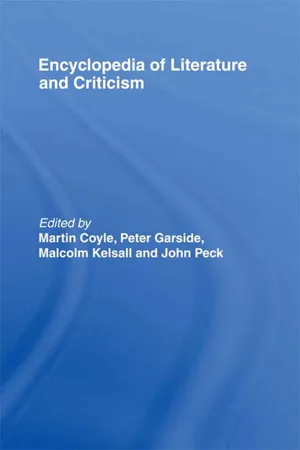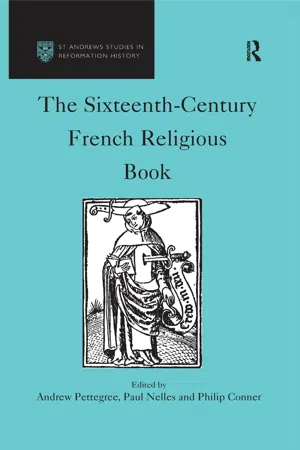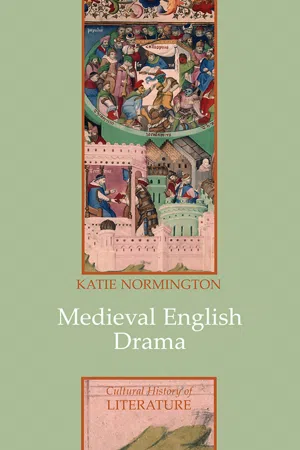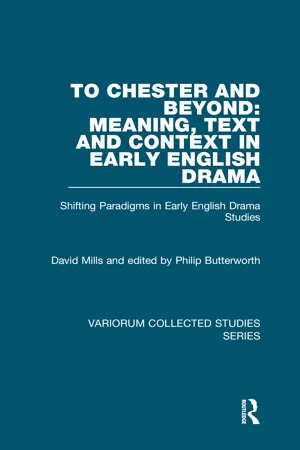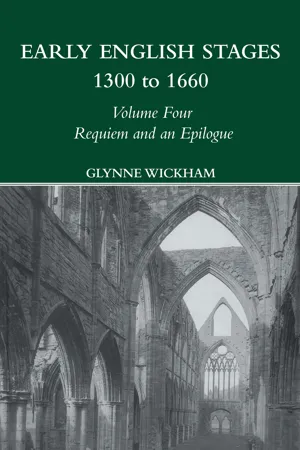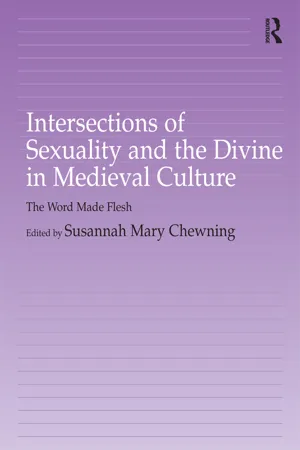Literature
Medieval Drama
Medieval drama refers to theatrical performances and plays that were popular in Europe during the Middle Ages, roughly from the 5th to the 15th century. These dramas often depicted religious themes and were performed as part of religious festivals and ceremonies. They played a significant role in the cultural and religious life of medieval society, and helped convey religious teachings to the largely illiterate population.
Written by Perlego with AI-assistance
Related key terms
Related key terms
1 of 4
Related key terms
1 of 3
10 Key excerpts on "Medieval Drama"
- eBook - ePub
- Peter Happe(Author)
- 2018(Publication Date)
- Routledge(Publisher)
Part IThe Medieval Drama
Passage contains an image
Chapter 3
Worship, Instruction and Entertainment: Liturgical Drama
Since the bulk of English drama before 1500 is religious, and since a very considerable portion of that surviving from the sixteenth century is either specifically didactic or substantially influenced by religious matters, we shall attempt in this chapter to give an account of the religious contexts in which the plays were written and performed. This will include a consideration of the liturgical drama, which is closely linked.In describing or contemplating Medieval Drama we ought not to impose distorting modern norms upon a varied corpus of plays, neither in terms of time, nor in terms of types of play, nor in terms of what the twentieth century has come to see as drama. For us the drama takes place on a stage, or on television, or on film or on radio. We may experience drama in a theatre with a proscenium arch, or in an arena, or in a village hall. Today a large part of the appreciation and understanding of drama also takes place by studying the texts of drama in printed books. All of these modes may help us to come closer to the Medieval Drama, but they all contain obstacles as well.Life in medieval times was much more orientated towards religion, both in outward forms like people’s occupations and also with regard to the inner life. There was a very strong sense of human impermanence, and religion was seen as a way of meeting many difficulties and misfortunes. Instability in society, and the proximity of life-threatening experiences such as the plague or childbirth are constant themes of preaching as well as of the various forms of consolation and instruction which the Church developed. On the other hand, worship also comprised joy and celebration and gave cause for hope. The work of the Church was concerned with both fear and the hope which transcended it. Thus to regard the religious content of the early plays as being about moral instruction alone is to narrow its scope too far. - eBook - ePub
- Martin Coyle, Peter Garside, Malcolm Kelsall, John Peck(Authors)
- 2002(Publication Date)
- Routledge(Publisher)
Rooted in the community and arising from key events in the social, spiritual and seasonal cycle, medieval plays depend for their rich intensity on that close association with the rhythms and moods of demotic life and the vigour and verve of popular speech also found in Chaucer, Langland and Skelton. Highly pictorial, relying on presentational rather than representational techniques, exhibiting a range of registers from formal hymns of adoration to satirical subversions of the temporal hierarchy, the drama of the Middle Ages is not in danger of falling out of fashion. It testifies to a firm belief that drama can render sharply and graphically abstract concept and didactic moral, and offer to reader and spectator a theatrical replication of ‘God’s plenty’ which exalts vitality and variety.What the twenty-first century holds is unclear: one suspects that for most people English drama will still begin with Shakespeare. Even the finest critics of today and tomorrow can probably never make the Medieval Drama familiar or accessible to the man in the street. Yet it cannot be denied that John R. Elliott Jr.’s words are even truer at the present time than when he wrote them in 1969:These plays have ceased to be mere historical curiosities and have become for us works of art, as impressive in their scope and intensity as the greatest products of medieval literature.Further Reading
- Bevington, David (ed.) (1975) Medieval Drama , Houghton Mifflin, Boston
- Happé, Peter (ed.) (1975) English Mystery Plays: A Selection , Penguin, Harmondsworth
- Hardison, O.B., Jr. (1965) Christian Rite and Christian Drama in the Middle Ages , Johns Hopkins University Press, Baltimore
- Kahrl, Stanley J. (1974) Traditions of English Medieval Drama , Hutchinson, London
- Kolve, V.A. (1966) The Play Called Corpus Christi , Edward Arnold, London
- Potter, Robert (1975) The English Morality Play: Origins, History and Influence of a Dramatic Tradition , Routledge & Kegan Paul, London
- Southern, Richard (1957) The Medieval Theatre in the Round , Faber & Faber, London
- Taylor, Jerome and Nelson, Alan H. (eds) (1972) Medieval English Drama: Essays Critical and Contextual , University of Chicago Press, Chicago
- Tydeman, William (1978) The Theatre in the Middle Ages: Western European Stage Conditions c. 800–1576
- eBook - ePub
- Andrew Pettegree, Paul Nelles(Authors)
- 2017(Publication Date)
- Routledge(Publisher)
CHAPTER TWO Religious drama and the printed book in France during the late fifteenth and sixteenth centuries Graham A. RunnallsIn the Middle Ages, drama was, in a very real sense, not literature; it was a visual and aural spectacle, which could only be ‘consumed’ in a theatre. In the post-medieval period, however, drama has become one of several recognized literary genres. By this I mean that members of the literate public are able to read plays privately in their own homes, without going to the theatre; indeed, nowadays drama is probably more read than seen in performance, certainly within schools and universities. In France, this change in the status of drama from spectacle to literature began to occur at the end of the fifteenth and into the sixteenth centuries. Its primary cause was arguably the invention and spread of printing.A vast amount of medieval French drama has survived, probably almost 550 texts. These include comic farces, satirical sotties, light-hearted or serious morality plays, and miracle and mystery plays. It is with the last two genres that I am primarily concerned, the so-called religious drama. These dramatizations of saints’ lives or of biblical material like the Passion and Resurrection of Christ or the Old Testament stories were usually major undertakings organized by a town, a confraternity or some other group of people. They are, in a sense, historical plays, in that they are dramatizations of events that the medieval public perceived as having really occurred. They are thus different from the farces, moralities and sotties, which were seen as fictional and imaginative. About 230 religious plays have come down to us, mostly from the fifteenth and sixteenth centuries, although two go back to the twelfth, two or three to the thirteenth and about 50 to the fourteenth century.1 Most religious plays in the fourteenth century were called miracles; mystery plays or mystères are not found before the fifteenth. About 180 mystères have survived; most were composed and performed between the mid-fifteenth and the mid-sixteenth centuries. Although some of these were relatively short plays, that is about 2000 or 3000 lines long and taking only three or four hours to perform, many were much longer. The performance of these longer plays had to be stretched out over several days or several journées (a journée was the amount of text that could be acted in one session): sometimes both morning and afternoon and lasting up to six or seven hours; sometimes just a three-hour performance during an afternoon. There are several examples of surviving plays which lasted 20 or 25 journées; - eBook - ePub
- Katie Normington(Author)
- 2013(Publication Date)
- Polity(Publisher)
There are a great number of other terms used in modern-day society to embrace a range of performance activities such as ritual, entertainment, show, or sometimes even game. The Middle Ages offered no such distinctions between types of dramatic entertainment. While there is evidence of separate terminology for what today would be distinguished as drama and music, or players and musicians (‘ludentes’ or ‘histriones’, 1 and ‘ministralli’ respectively), it is difficult to determine how early performances were categorized by contemporary audiences, or if indeed they were. This book includes reference to a broad range of entertainments. Although some written texts have survived from the period it is important to acknowledge that within Medieval England there was a huge variety of festivities which included summer games, festive processions, and ritual practices for which no spoken texts exist. One major difference between performance in the Middle Ages and that of the modern-day was the influence of religious practices and beliefs. As shall be shown in the chapters that follow, early drama held a close relationship with liturgical practice both through the services conducted within the Church and the celebration of the ecclesiastical calendar within the parish - eBook - ePub
To Chester and Beyond: Meaning, Text and Context in Early English Drama
Shifting Paradigms in Early English Drama Studies
- David Mills, Philip Butterworth(Authors)
- 2023(Publication Date)
- Routledge(Publisher)
10 The application of these terms, with all their modern connotations, to Medieval Dramatic activities may lead critics to dwell upon certain aspects of these activities, to the exclusion of other important features, and may suggest a degree of continuity between medieval and modern play-construction which is unhelpful or even misleading. It is extremely difficult to make clear distinctions between the various forms of dramatic activity in the Middle Ages, to determine the limits of the play, the liturgy, the civic procession, the sermon, the tournament, the dance. It is also uncertain how far the Middle Ages themselves were aware of the drama as a distinct genre. I do not wish to advocate a new critical terminology for Medieval Drama, but it will be necessary to consider what the familiar terms signify when applied to this drama.The ‘Liturgical’ Approach
Perhaps nowhere is it more important to be aware of the significance of traditional terminology than in the discussion of the beginnings of Medieval Drama. Critics who define drama as the coming-together of distinct elements, such as action, impersonation and dialogue,11 have argued that the origins of Medieval Drama lie in the liturgical plays of the Church, themselves developments from earlier liturgical observances, and that the Latin liturgical drama evolves into vernacular drama by the growth of its constituent elements, which are still present in the later play-cycles. Such an idea underlies Chambers’s account of secularisation:The evolution of the liturgic play … may be fairly held to have been complete about the middle of the thirteenth century … The following hundred years are a transition period. During their course, the newly shaped drama underwent a process which, within the limits imposed by the fact that its subject-matter remained essentially religious, may be called secularization … From ecclesiastical the drama had become popular. Out of the hands of the clergy in their naves and choirs, it had passed to those of the laity in their marketplaces and guild-halls. And to this formal change corresponded a spiritual or literary one, in the reaction of the temper of the folk upon the handling of the plays, the broadening of their human as distinct from their religious aspect. In their origin officia for devotion and edification, they came, by an irony familiar to the psychologist, to be primarily spectacula for mirth, wonder and delight.12 - eBook - ePub
- Jody Enders, Jody Enders(Authors)
- 2019(Publication Date)
- Methuen Drama(Publisher)
morality play, procession, miracle, farce, fool’s play, dialogue, debate, discourse or allegory.70 But, if anything, the category of ‘dramatic literature’ has tended to obscure the rich sociocultural settings in which medieval theatre happened. Following Le Goff’s insistence on an omnipresent medieval theatricality or Paul Zumthor’s on theatre as the most ‘social of all the media and the most receptive to changes in the social structure’, it proves far more profitable to approach a fungible medium with the more fungible language of ‘theatre’, ‘performance’, ‘media’ or ‘theatricality’. The mysteries of the culture that gave us the mystery play may thereby come to light, newly exemplary of the interdiscipline that we now dub ‘performance studies’.71Even in the Middle Ages, an epoch wont to taxonomize, Medieval Drama is so tricky to identify that its very name is interspersed liberally with spectacle, sport, tournament, ritual, battle play, trial, pageant, parade, procession, preaching, politics, proclamation, scholastic disputation, oratory, music, dance, song, pantomime and protest. Belying a hermeneutic instability akin to T.S. Eliot’s later confusion des genres,72 it is a shape-shifter, an embodiment of mouvance at the level of genre. Already in the Etymologies, Isidore of Seville had grouped together sixty-nine cultural events under the heading ‘Of War and Play [ludus]’. In a veritable primer for performance studies, he included warfare, forensic rhetoric, gladiatorial combat, horse racing, dice games, religion, the circus, the amphitheatre, comedy and tragedy based on their shared affinity for displaying in privileged spaces what Johan Huizinga would go on to term ‘glorious exhibitionism and agonistic aspiration’.73 It is no coincidence that, in his stellar review article for New Medieval Literatures, ‘Medieval Literature and Cultures of Performance’, Bruce Holsinger turns to anthropology and ethnomusicology, broaching Richard Schechner’s foundational question: ‘Is there anything outside the purview of performance studies?’74 Much as I once argued for a performance continuum, Holsinger advocates that we ‘conceive of oral-formulaic studies and performance studies as two ends of a methodological continuum’.75 - eBook - ePub
Drama and the Theatre with Radio, Film and Television
An outline for the student
- John Russell Brown, John Russell Brown(Authors)
- 2023(Publication Date)
- Routledge(Publisher)
Visitatio Sepulchri was close to ritual. The greatest development of the new tradition took place outside the church. Sponsored by Christian laymen, the liturgical plays developed into the miracle or mystery plays, performed in the vernacular with much spectacle on the feast of Corpus Christi by members of the guilds of the towns which grew and prospered in the late Middle Ages. Drawing their material from the Bible, these told the story of the creation and the fall and redemption of man. There were other plays which dealt with the legends of the saints. A quite different genre was the morality play, more concerned with the direct preaching of the Christian message, and employing symbolism to bring the message home to the spectators.This association of drama with religion is one of the reasons for the long series of prohibitions laid upon drama: the forbidding, in Deuteronomy, of the exchange of clothes between the sexes, originally directed against some pagan dramatic ritual and invoked by Zeal-of-the-land Busy in Bartholomew Fair; the excommunication of actors in fourth-century Rome and in seventeenth-century France, where Molière was at first refused Christian burial; the banning of the Catholic miracle plays by the Reformed Church in the sixteenth century; the Catholic and Protestant suppression of folk plays and rituals; the long Puritan and Nonconformist attacks on the stage; Marxist censorship. In all of these instances, the drama is involved in the struggle between one system of belief and another.The State and the Drama
The performance of a Greek play was a state occasion, attended by civic leaders and foreign ambassadors. The costs were borne by public-spirited citizens or came from public funds. In the fifth century, the tragedies of Aeschylus, Sophocles and Euripides and the comedies of Aristophanes handled great political, social and moral issues. It is only very exceptionally, however, that we find a government with sufficient faith in the drama and democracy to allow such freedom of expression, let alone sponsor it. Political tensions already began to curb the freedom of Aristophanes in his later comedies, and, a century later, Menander, in his so-called ‘new comedy’, had to confine himself to non-political domestic stories. It is not until we come to the Reformation and the freedom created by the balance of power between opposing parties, that we again find the drama discussing great issues confronting nations, but only in a partisan spirit. The established morality form lent itself admirably to this function. The most striking example is Sir David Lindsay’s Satire of The Three Estates, which, when it was performed in Edinburgh in 1554, was paid for by the Corporation and presented before the Queen Regent and a great assembly of lords and commons. This reappearance of a political drama was short-lived. In Scotland, the Reformed Kirk, strongly influenced by English Puritanism, was powerful enough to put an end to dramatic performances. In England, where, by the Act of 1572, players could incur the penalties of the law as ‘rogues and vagabonds’, Queen Elizabeth stood between the players and the Puritans; but her government, by various legal enactments, ensured that the drama should not call in question either the established church or government policy, a course which, in any case, playwrights and theatrical companies became less and less likely to follow, since they were increasingly dependent on a court audience. All the English companies were required by law to serve under a noble patron, and, under James I, the company of which Shakespeare was a member became ‘the King’s Men’ and could be regarded as the first national theatre company. The theatres were closed by Parliament in 1642, and the ban continued throughout the Commonwealth period. At the Restoration, the King granted patents for two theatres and two companies, one of which was established under his own patronage, the other under the Duke of York’s, continuing the association of the drama with the court. It was not until the 1720s and 1730s, with the Beggar’s Opera - eBook - ePub
- Glynne Wickham(Author)
- 2023(Publication Date)
- Routledge(Publisher)
From this there could be no looking back. The art of drama, as first reborn within the liturgies of the Christian Church, had escaped—albeit while still under strictly authoritarian ecclesiastical control—not only into market places and onto village greens, but into baronial and civic banquet halls, all of which lay under secular control. Thenceforward, its future legitimacy would inevitably have to be determined by arguments advanced from these quarters rather than from sources emanating from the Church alone.Firm foundations had thus come to be laid for the creation of a theatrical world to which further and more varied additions could be made but which, while still faithful to its liturgical origins in Red Letter Calendar Festivals, would remain familiar to play-makers, actors and their audiences alike during the opening decades of the sixteenth century, when a growing clamour for the reformation of sleaze, corruption and superstition in all aspects of ecclesiastical life and practice would open all of these long-inherited theatrical assumptions to vigorous questioning, and to violently expressed divisions of public opinion in Germany, Switzerland and France.One further innovation of thirteenth-century origin, however, remains to be taken into account here, since it was to have still wider implications for the subsequent development of dramatic art and the several forms of theatrical presentation that both could take by then. This was the founding of what we now call ‘Universities’. These came into existence when the Vatican was persuaded to allow the creation of collective groups of monastic houses, or colleges, in certain European cities devoted principally to the teaching and training of students between the ages of fourteen and eighteen to ensure a regular supply of young men well enough prepared intellectually to embark upon careers in the priesthood, the law and the civil service as clerks. - Eva von Contzen, Chanita Goodblatt(Authors)
- 2020(Publication Date)
- Manchester University Press(Publisher)
Staging Conventions in Medieval English Theatre (Cambridge: Cambridge University Press, 2014); Clifford Davidson, Festivals and Plays in Late Medieval Britain (Aldershot: Ashgate, 2007); Penny Granger, The N-Town Play: Drama and Liturgy in Medieval East Anglia (Cambridge: Brewer, 2009); Peter Happé (ed.), Medieval English Drama: A Casebook (London: Macmillan, 1984); Stanley J. Kahrl, ‘The Staging of Medieval English Plays’, in Eckehard Simon (ed.), The Theatre of Medieval Europe: New Research in Early Drama (Cambridge: Cambridge University Press, 1991), pp. 130–48; James Mervyn, ‘Ritual, Drama and Social Body in the Late Medieval English Town’, in John C. Coldewey (ed.), Medieval Drama: Critical Concepts in Literary and Cultural Studies, Vol. II: English Cycle Plays: Studies Past and Present (London and New York: Routledge, 2007), pp. 70–97.8 Butterworth, Staging Conventions, p. 169.9 On the influence of the liturgy and the didactic potential, see e.g. Meg Twycross, ‘Books for the Unlearned’, in James Redmond (ed.), Drama and Religion (Cambridge: Cambridge University Press, 1983), pp. 65–110. The communal context is stressed e.g. by Matthew John Sergi, ‘Play Texts and Public Practice in the Chester Cycle, 1422–1607’, Ph.D. dissertation, University of California, Berkeley, 2011 and the chapters in Alan Hindley (ed.), Drama and Community: People and Plays in Medieval Europe (Turnhout: Brepols, 1999) and Simon, Theatre of Medieval Europe. On late medieval visuality and its affective dimension, see e.g. Hans Belting, The Image and its Public in the Middle Ages: Form and Function of Early Paintings of the Passion, trans. M. Bartusis and R. Meyer (New Rochelle, NY: Caratzas, 1990); Suzannah Biernhoff, Sight and Embodiment in the Middle Ages (New York: Palgrave Macmillan, 2002); Andrea Louise Young, Vision and Audience in Medieval Drama: A Study of The Castle of Perseverance (New York: Palgrave Macmillan, 2015).10 See e.g. Guillemette Bolens, The Style of Gestures: Embodiment and Cognition in Literary Narrative- eBook - ePub
Intersections of Sexuality and the Divine in Medieval Culture
The Word Made Flesh
- Susannah Chewning(Author)
- 2017(Publication Date)
- Routledge(Publisher)
Part ISecular Literature and DramaPassage contains an image
Chapter 2
Michael W. GeorgeReligion, Sexuality, and Representation in the York Joseph's Troubles PageantIn a volume dealing with the intersection of religion and sexuality, it seems appropriate that two subjects not be omitted: Medieval Drama and comic sexuality. In this article, I will look at both topics at once, since the medieval English cycle plays include a good amount of humor within their spiritual structure. Although religion and sexuality intersect in various places in morality and miracle plays, perhaps nowhere do they collide with such hilarity as they do in the York "Joseph's Troubles" pageant.1 stage, the intersections between religion and sexuality and its ramifications are. The playwright takes the all-too-familiar elements of fabliaux humor and inserts them into a religious cycle. The manner in which religion intersects sexuality in this pageant depends upon representation, so that the pageant is, on one level, about conflicting representations, one faulty and hence ridiculous, the other proper.The foundation of my analysis is that this pageant is drama and not literature. The difference is often slight in scholarly circles, but dramatic representation depends upon performance, and the issue central to this pageant is representation, for the playwright has Joseph represent Mary, both to himself and to the audience, as someone very different from the expectations of audience and characters alike. The central conflict that drives the humor in this pageant stems from the collision of representations.Dramatic representation is not static, as is representation in a literary text. Each performance of a particular play is different. Although the script may remain more or less static, the actors, and hence performance, do not. Dramatic representation in the medieval English cycles could be problematic because of the familiarity of producer and audience. Because the craft guilds were responsible for producing the pageants, those involved in the productions were probably not professional actors but instead guild members and townspeople, the same people that many in the audience would see daily on the streets. Thus the players were known to many in the audience.
Index pages curate the most relevant extracts from our library of academic textbooks. They’ve been created using an in-house natural language model (NLM), each adding context and meaning to key research topics.
Explore more topic indexes
Explore more topic indexes
1 of 6
Explore more topic indexes
1 of 4

